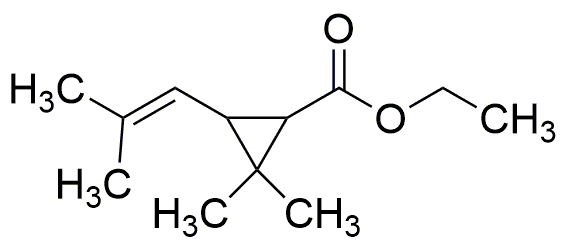Ethyl 2,2-dimethyl-3-(2-methyl-1-propenyl)cyclopropane-1-carboxylate is widely utilized in research focused on:
- Flavor and Fragrance Industry: This compound is used in the formulation of flavors and fragrances due to its pleasant aroma, enhancing products like perfumes and food flavorings.
- Agricultural Applications: It serves as an intermediate in the synthesis of agrochemicals, contributing to the development of effective pesticides and herbicides that improve crop yields.
- Pharmaceutical Development: The compound is explored for its potential in drug synthesis, particularly in creating new therapeutic agents that target specific health conditions.
- Polymer Chemistry: It is employed in the production of specialty polymers, offering unique properties that can enhance material performance in various applications.
- Research and Development: This chemical is a valuable tool in academic and industrial research settings, facilitating studies in organic synthesis and reaction mechanisms.
Informations générales
Propriétés
Sécurité et réglementation
Applications
Ethyl 2,2-dimethyl-3-(2-methyl-1-propenyl)cyclopropane-1-carboxylate is widely utilized in research focused on:
- Flavor and Fragrance Industry: This compound is used in the formulation of flavors and fragrances due to its pleasant aroma, enhancing products like perfumes and food flavorings.
- Agricultural Applications: It serves as an intermediate in the synthesis of agrochemicals, contributing to the development of effective pesticides and herbicides that improve crop yields.
- Pharmaceutical Development: The compound is explored for its potential in drug synthesis, particularly in creating new therapeutic agents that target specific health conditions.
- Polymer Chemistry: It is employed in the production of specialty polymers, offering unique properties that can enhance material performance in various applications.
- Research and Development: This chemical is a valuable tool in academic and industrial research settings, facilitating studies in organic synthesis and reaction mechanisms.
Documents
Fiches de données de sécurité (FDS)
La FDS fournit des informations de sécurité complètes sur la manipulation, le stockage et l’élimination du produit.
Spécifications du produit (PS)
Le PS fournit une description complète des propriétés du produit, notamment sa composition chimique, son état physique, sa pureté et les exigences de stockage. Il détaille également les plages de qualité acceptables et les applications prévues du produit.
Certificats d'analyse (COA)
Recherchez des certificats d'analyse (COA) en saisissant le numéro de lot du produit. Les numéros de lot et de lot se trouvent sur l'étiquette d'un produit, après les mots « Lot » ou « Lot de fabrication ».
Numéro de catalogue
Numéro de lot/série
Certificats d'origine (COO)
Ce certificat d'exploitation confirme le pays dans lequel le produit a été fabriqué, et détaille également les matériaux et composants utilisés et s'il est issu de sources naturelles, synthétiques ou autres sources spécifiques. Ce certificat peut être requis pour les douanes, le commerce et la conformité réglementaire.
Numéro de catalogue
Numéro de lot/série
Fiches de données de sécurité (FDS)
La FDS fournit des informations de sécurité complètes sur la manipulation, le stockage et l’élimination du produit.
DownloadSpécifications du produit (PS)
Le PS fournit une description complète des propriétés du produit, notamment sa composition chimique, son état physique, sa pureté et les exigences de stockage. Il détaille également les plages de qualité acceptables et les applications prévues du produit.
DownloadCertificats d'analyse (COA)
Recherchez des certificats d'analyse (COA) en saisissant le numéro de lot du produit. Les numéros de lot et de lot se trouvent sur l'étiquette d'un produit, après les mots « Lot » ou « Lot de fabrication ».
Numéro de catalogue
Numéro de lot/série
Certificats d'origine (COO)
Ce certificat d'exploitation confirme le pays dans lequel le produit a été fabriqué, et détaille également les matériaux et composants utilisés et s'il est issu de sources naturelles, synthétiques ou autres sources spécifiques. Ce certificat peut être requis pour les douanes, le commerce et la conformité réglementaire.

